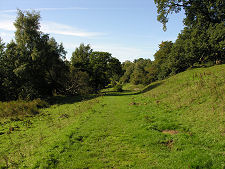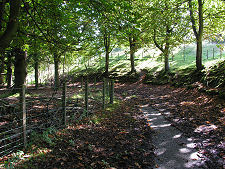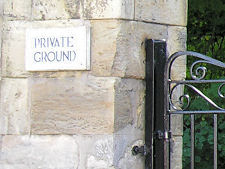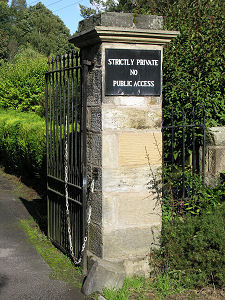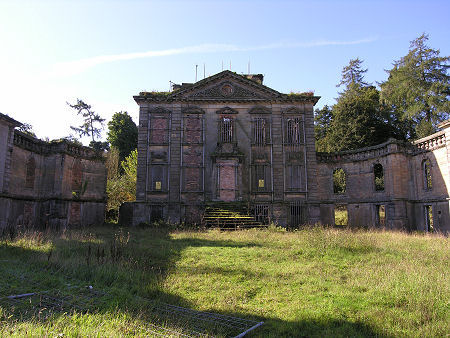 The East Facing Front of Mavisbank in 2006: Though the Security Fencing |
One of the Scottish buildings featured in the first series of the BBC's "Restoration" in 2003 was Mavisbank. Lying under 6 miles southeast of the centre of Edinburgh and just to the east of Loanhead, Mavisbank is universally regarded as one of Scotland's finest buildings: in many ways THE key building of the early Georgian period in this country. Yet today this "A" Listed masterpiece lies almost forgotten, almost inaccessible, and in such a fragile and precarious state it is easy to believe from the front that it is no more than a stage set, a facade that could blow over or crumble away with the slightest breath of wind.
The good news is that Mavisbank is not forgotten. The Mavisbank Trust aims to bring the house and grounds back to use, working alongside Historic Environment Scotland who now own the property. The immediate aim is to restore the shell of the house and to open the extensive grounds to the public, allowing Mavisbank to form part of a wider network of paths and cycleways in the North Esk Valley linking it to Roslin Glen, Rosslyn Castle, Rosslyn Chapel, the Bilston Glen Viaduct, Melville Castle and Dalkeith Country Park.
Even this apparently modest ambition will entail a vast amount of work and a considerable amount of funding. The house really is in a very precarious state, held up more by scaffolding poles and infilling brickwork than by the remaining strength of its own structure. And the surrounding parkland and gardens have largely reverted to the wild; with access, at best, difficult.
Let's look at access first. The house itself is thankfully surrounded by a security fence placed there for the protection of what is left of the structure from visitors: and for the protection of visitors from falling bits of what is left of the structure. The gardens outside the security fence have closed in on the house, effectively hemming it in with an almost impenetrable mass of vegetation on every side except the east: the direction in which Mavisbank faces along this north side of the valley of the River North Esk.
The most difficult problem is getting from the surrounding network of roads into Mavisbank's grounds. There used to be three drives leading through the park to the house from different directions. One curved its way down the valley side from the north, passing through a gateway from the A768 on the outskirts of Loanhead. The second approached from the south via a gateway close to the north end of a bridge carrying a minor road across the River North Esk, passing the old walled gardens en route to the house. And the third approached from the North-East, through a gate leading off Kevock Road just to the north of where a large pink house now stands on a corner. From here it made its way along the side of the valley.
All three drives met at a junction a couple of hundred yards to the east of Mavisbank itself. Today the old north or south drives present closed gates and/or signs seeking to deter casual visitors. They reflect the fact that parts of the drives were sold off to neighbouring landowners who now use them for access to their own properties: though whether all aspects of the current situation are entirely consistent with Scotland's access legislation may be debatable.
The only undisputed route into Mavisbank is from the gateway on Kevock Road. Anyone proposing to follow in our footsteps and approach from this direction should be aware that, although it is not much more than a half mile walk, the return to the wild of the parkland has been so complete that the terrain is quite difficult. The first few hundred yards follow a muddy path along the top of an escarpment, before you descend very steeply into the valley, eventually finding something it is easier to accept was once a drive leading to a grand house: though even here there are extremely boggy stretches. On a more positive note, the depth of the wilderness has made this an attractive place for wildlife, including roe deer.
Why is Mavisbank so special? The house was built in the Palladian style between 1723 and 1727 for Sir John Clerk of Penicuik by the architect William Adam. It originally comprised just a single main block, five bays wide with a basement and two storeys. When this proved too small, pavilions were built each side of the house, though forward of it. These were linked to the main block by quadrant wings. The end result was described by a commentator at the time as: "in the true Palladio tastes one of the most elegant I ever saw for structure, situation, wood and water...you would think yourself rather in a valley near Tivoli than Edinburgh."
The park extending to the east was landscaped, with radial avenues and a canal which lined up with the centre of the house and extended as far as a dovecote built in 1738 towards the east end of the parkland. A gazebo and walled garden lay out of sight of the house to the south. Immediately behind the house the land rose through gardens to the remains of an iron age fort.
In 1876 Mavisbank was renamed New Saughton Hall and turned into a lunatic asylum, with new wings erected behind the quadrants to provide additional accommodation. It was retired as a hospital in 1946, being purchased by its last Medical Superintendent, who returned it to use as a family home, demolishing the extensions built in the 1800s. In the 1950s the house was purchased by Archie Stevenson, who presided over 20 years of steady decline that saw Mavisbank become a dump for old vehicles before finally suffering a serious fire.
Mavisbank was saved at the last minute from demolition in the 1980s, but Archie Stevenson's wilful neglect of the house continued beyond the grave: in his will he left it in equal parts to three (probably fictitious) nominees in the United States named after pop stars from the 1960s, a move almost certainly designed to make establishing future ownership (and saving the house) as complicated and as expensive as possible.
In the end Historic Environment Scotland used emergency powers to stabilise the shell of the house and purchase the surrounding grounds on behalf of the government. Given its history over the past 130 years, perhaps the real surprise is not the poor state of Mavisbank: but rather that enough of it remains (hopefully) to allow its eventual restoration.
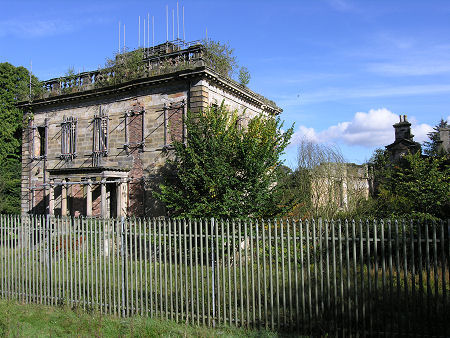 The West Side of Mavisbank |

|
|
|
Visitor InformationView Location on MapGrid Ref: NT 288 652 www.mavisbank.org.uk What3Words Location: ///resists.tasks.situates |
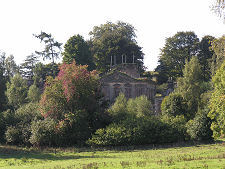 More Distant View from the East |
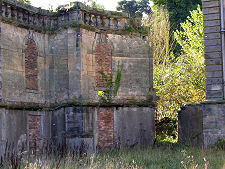 Arcade Leading to South Wing |
 Ornate Chimneys |
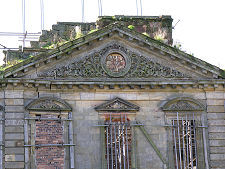 And Pediment |
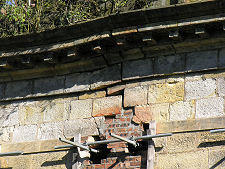 Wall at Top of Rear of House |
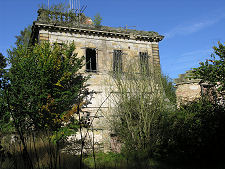 South Side of the House |
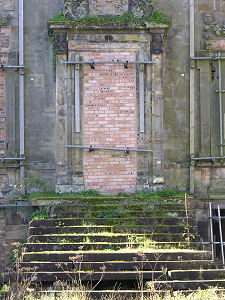 The Front Door |

